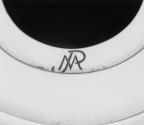Advanced Search
Covered urn
John Paul Miller (American, 1918–2013)
1951
Object Place: Cleveland, Ohio, United States
Medium/Technique
Silver, gold
Dimensions
Overall: 18.4 x 6.2 x 6.8 cm (7 1/4 x 2 7/16 x 2 11/16 in.)
Credit Line
Gift of John Paul Miller
Accession Number2001.158a-b
NOT ON VIEW
CollectionsAmericas
ClassificationsSilver hollowware
Beautifully raised and perfectly planished, with a simple granulated design of a sunburst set into the short stem and finial, this covered vase exemplifies the high standards of midcentury silversmithing advanced by the Handy and Harman conferences. All the elements have been fully considered and developed, resulting in a well-balanced and elegant composition.
Internationally renowned for his enameled and granulated jewelry (see fig. 5), John Paul Miller produced this urn while enrolled as a participant in the 1951 Handy and Harman silversmithing conference. The conference was held that year at the School for American Craftsmen in Rochester, New York.
Miller had just begun to experiment with granulation, evident in the little sunbursts on the vase’s baluster and lid. Miller recalled that “in 1940 I happened to come across photos of granulation by Elizabeth Treskow in a German art magazine called Die Kunst. I couldn’t understand the German and I knew nothing about granulation — including its name — but the work fascinated me.” He became one of the acknowledged masters of the technique.
Justly celebrated for his jewelry, Miller participated in numerous exhibitions, most frequently the “May Shows” organized by the Cleveland Museum of Art. A graduate of the Cleveland Art School (now the Cleveland Institute of Art), he went on to teach at his alma mater. Among his best-known students are Frank Marshall, professor emeritus of the University of Washington, Seattle; enamelist William Harper; and Lisa Norton, professor of metalsmithing at the Art Institute of Chicago. The American Crafts Council awarded its gold medal for excellence to Miller in 1994.
This text has been adapted from "Silver of the Americas, 1600-2000," edited by Jeannine Falino and Gerald W.R. Ward, published in 2008 by the MFA. Complete references can be found in that publication.
Internationally renowned for his enameled and granulated jewelry (see fig. 5), John Paul Miller produced this urn while enrolled as a participant in the 1951 Handy and Harman silversmithing conference. The conference was held that year at the School for American Craftsmen in Rochester, New York.
Miller had just begun to experiment with granulation, evident in the little sunbursts on the vase’s baluster and lid. Miller recalled that “in 1940 I happened to come across photos of granulation by Elizabeth Treskow in a German art magazine called Die Kunst. I couldn’t understand the German and I knew nothing about granulation — including its name — but the work fascinated me.” He became one of the acknowledged masters of the technique.
Justly celebrated for his jewelry, Miller participated in numerous exhibitions, most frequently the “May Shows” organized by the Cleveland Museum of Art. A graduate of the Cleveland Art School (now the Cleveland Institute of Art), he went on to teach at his alma mater. Among his best-known students are Frank Marshall, professor emeritus of the University of Washington, Seattle; enamelist William Harper; and Lisa Norton, professor of metalsmithing at the Art Institute of Chicago. The American Crafts Council awarded its gold medal for excellence to Miller in 1994.
This text has been adapted from "Silver of the Americas, 1600-2000," edited by Jeannine Falino and Gerald W.R. Ward, published in 2008 by the MFA. Complete references can be found in that publication.
DescriptionThe tall raised vessel is of elongated convex form and rises to a slightly everted rim. Its short stem contains four rectangular reserves. Of these, two display a sun motif of saw-cut flames and a central gold disk, on which a face has been delineated in granulated gold. The design has been soldered to an oxidized silver ground for contrast. The two sun images alternate with undecorated reserves. A flat base with an applied edge supports the vessel. The circular lid has a narrow flange and a stepped edge. The finial, soldered to the lid, is in three sections. Of these, a small flat disk supports a wide cone that is 11/16 in. (2.7 cm) in diameter. At the center of this form is a second cone that has been capped with a third sun disk.
Marks
Incuse mark "JPM" struck on base; incuse, san serif letters "STERLING" also struck on base
InscriptionsNone.
ProvenanceThe urn was made during the Handy and Harman silversmithing conference of 1951; retained by the artist until made a gift to the Museum.
CopyrightReproduced with permission.




